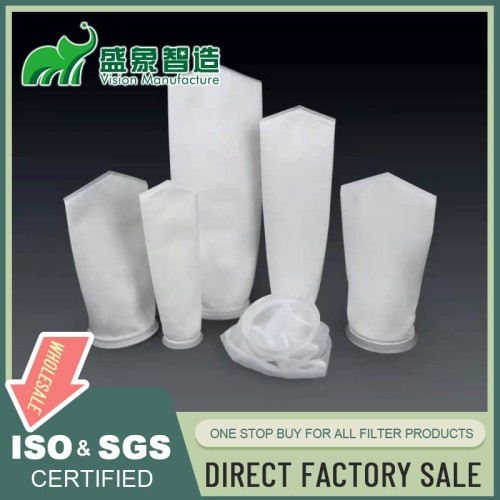
200 Micron Nylon Mesh Bags Offer Versatile Filtration Solutions
I. Introduction
Nylon mesh plays a pivotal role in industrial filtration, offering a balance of durability and efficiency. This introduction explores the significance of 200 micron nylon mesh bags, highlighting their versatility across various industrial applications and their impact on enhancing filtration processes.
II. Properties of 200 Micron Nylon Mesh
- Material Characteristics of Nylon: Nylon is renowned for its strength, flexibility, and chemical resistance, making it ideal for filtration applications.
- Mesh Structure and Weave Patterns: The structure and weave of the nylon mesh determine its suitability for different filtration needs.
- Filtration Efficiency at 200 Microns: At this micron rating, nylon mesh effectively balances flow rate and particle retention, making it suitable for a variety of applications.
III. Types of 200 Micron Nylon Mesh Bags
- Monofilament Mesh Bags: Feature single-thread construction that provides excellent strength and surface filtration.
- Multifilament Mesh Bags: Consist of multiple fibers twisted together, offering depth filtration.
- Custom-designed Mesh Bags: Tailored solutions designed to meet specific filtration requirements and challenges.
IV. Applications Across Industries
200 micron nylon mesh bags are utilized in diverse sectors due to their effective filtration capabilities:
- Water and Wastewater Treatment: Essential for removing particulates from water.
- Food and Beverage Processing: Used to ensure the clarity and purity of consumables.
- Chemical Manufacturing: Filters out impurities that can affect chemical reactions and product purity.
- Pharmaceutical Production: Critical in maintaining contaminant-free conditions in drug production.
- Automotive Fluids Filtration: Ensures the cleanliness of fluids essential for vehicle performance.
- Paint and Coatings Industry: Captures particulates to ensure smooth finishes.
V. Key Features and Benefits
- High Flow Rates: Allows for the efficient processing of large volumes of fluid.
- Good Particle Retention: Effectively traps and holds particles at the 200-micron level.
- Chemical Resistance: Suitable for use with a range of chemicals without degrading.
- Durability and Reusability: Offers a long service life with possibilities for multiple uses.
- Cost-effectiveness: Provides a balance between performance and expense, making it a viable option for many businesses.
VI. Design Considerations
- Bag Dimensions and Shapes: Available in various sizes to fit different systems.
- Seam Types and Construction: Ensures durability and prevents leakage.
- Closure and Attachment Methods: Includes options like zip, tie, or elastic openings for secure closure.
- Reinforcement Options: Additional features like rings or flanges to support installation and operation.
VII. Performance Characteristics
- Flow Rate Capabilities: Handles high volumes efficiently.
- Dirt-Holding Capacity: Measures how much particulate the bags can capture before cleaning is required.
- Pressure Drop Profiles: Minimizes resistance to maintain energy efficiency.
- Cleaning and Regeneration Potential: Bags can be cleaned and reused, extending their service life.
VIII. Selection Criteria
- Process Requirements Assessment: Understanding the specific needs of the filtration system.
- Compatibility with Filtered Materials: Ensuring the bag's material properties match the substances being filtered.
- Operating Conditions: Considering factors like flow rate, pressure, and temperature.
- Regulatory Compliance Needs: Meeting industry-specific environmental and safety standards.
IX. Installation and Usage
- Proper Handling Techniques: Ensuring the bags are not damaged during installation.
- Installation Best Practices: Tips for ensuring the bags are correctly placed and secured.
- Initial Rinse and Preparation: Preparing the bags for operation to optimize performance.
- Monitoring During Operation: Keeping track of performance to maintain efficiency.
X. Maintenance and Cleaning
- Inspection Routines: Regular checks to ensure the bags are functioning properly.
- Cleaning Methods and Frequency: Recommendations for cleaning to maintain optimal performance.
- Regeneration Techniques: Methods to restore filtration efficiency.
- Storage Between Uses: Proper storage practices to prolong the life of the bags.
XI. Comparative Analysis
- 200 Micron vs. Other Common Mesh Sizes: Evaluates the benefits of using 200 micron bags over other sizes.
- Nylon Mesh vs. Other Filter Materials: Discusses the advantages of nylon compared to materials like polyester or polypropylene.
- Cost-Benefit Analysis in Various Applications: Assesses the economic impacts of using 200 micron nylon mesh bags.
XII. Environmental Considerations
- Reusability and Waste Reduction: Highlights the environmental benefits of using reusable filter bags.
- Energy Efficiency in Filtration Processes: Discusses how effective filtration can lead to energy savings.
- Recyclability of Nylon Materials: Focuses on the sustainability aspects of using nylon.
- Sustainable Manufacturing Practices: Emphasizes the importance of environmentally friendly production methods.
XIII. Case Studies
- Improving Water Filtration Efficiency: Examples of how 200 micron bags have enhanced water treatment processes.
- Enhancing Product Quality in Food Processing: Demonstrates the role of nylon mesh in maintaining high standards in food production.
- Optimizing Chemical Manufacturing Processes: Shows how effective filtration contributes to better product purity.
- Solving Contamination Issues in Automotive Fluids: Discusses the benefits of using nylon mesh in automotive applications.
XIV. Technological Advancements
- Advanced Nylon Materials for Enhanced Performance: Innovations in nylon technology that improve filtration efficiency.
- Integration with Smart Monitoring Systems: The use of technology to monitor and optimize filtration processes.
- Customization for Specific Industry Needs: Tailored solutions that address unique challenges in various industries.
- Innovations in Mesh Design and Manufacturing: Developments that enhance the performance and usability of nylon mesh bags.
XV. Regulatory Compliance
- FDA Requirements for Food and Pharma Applications: Ensures that nylon mesh bags meet stringent health and safety standards.
- EPA Guidelines for Water Treatment: Compliance with environmental regulations to ensure clean and safe water.
- Industry-specific Standards and Certifications: Adherence to standards that govern specific industries and applications.
XVI. Conclusion
200 micron nylon mesh bags are essential tools in industrial filtration, offering unmatched precision and efficiency. As industries increasingly focus on enhancing filtration processes, these bags provide a reliable and cost-effective solution. For organizations looking to optimize their filtration systems, embracing these advanced solutions is a strategic move towards achieving superior operational outcomes.
Leave a comment

